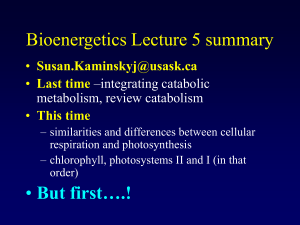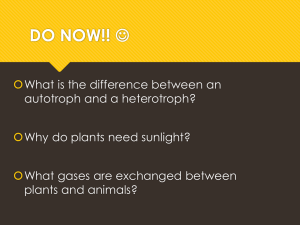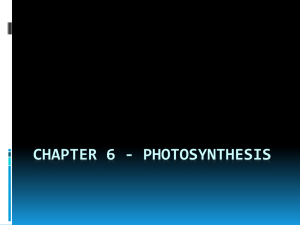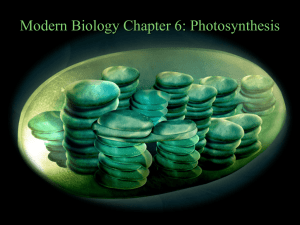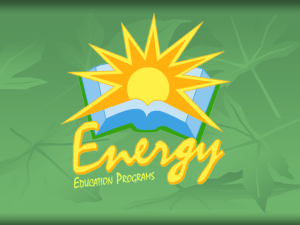Light Reactions
advertisement
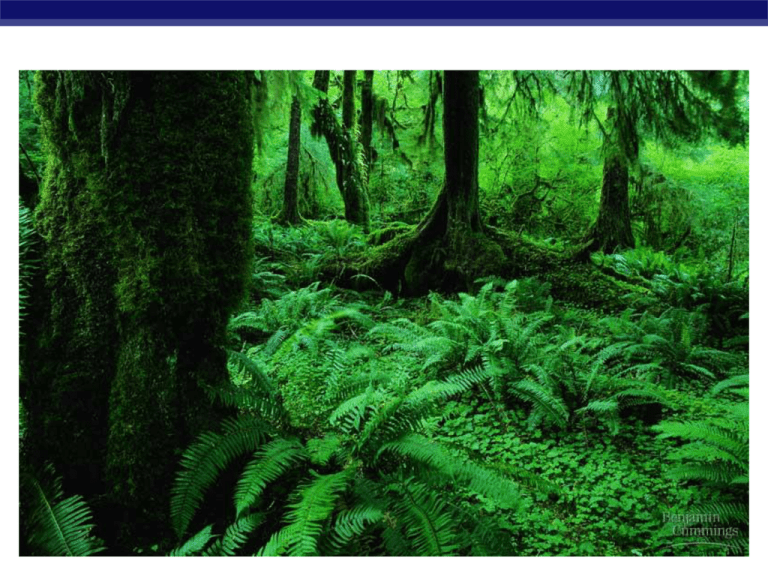
Photosynthesis: Life from Light and CO2 Energy needs of life All life needs a constant input of energy Heterotrophs (Animals) Get energy…. consumers Convert energy…. Autotrophs (Plants) Ger energy… convert energy… producers build organic molecules (CHO) from CO2 What does it mean to be a plant Need to… collect light energy ATP transform it into chemical energy glucose store light energy in a stable form to be moved around the plant or stored need to get building block atoms CO 2 from the environment C,H,O,N,P,K,S,Mg produce all organic molecules needed for growth H2O N K P … carbohydrates, proteins, lipids, nucleic acids Plant structure What structures do the following? Absorb sunlight leaves = solar pigments Obtain CO2 stomates H2O uptake from roots nutrients N, P, K, S, Mg, Fe… uptake from roots stomate transpiration gas exchange Chloroplasts leaves cross section of leaf absorb sunlight & CO2 CO2 chloroplasts in plant cell chloroplast chloroplasts contain chlorophyll make energy & sugar chloroplast H+ Plant structure ATP + + H+ H H+ + H H + H+ H+ H+ + H H thylakoid Chloroplasts double membrane stroma outer membrane inner membrane fluid-filled interior thylakoid sacs grana stacks stroma Thylakoid membrane contains chlorophyll molecules electron transport chain ATP synthase H+ gradient built up within thylakoid sac thylakoid granum Photosynthesis Light reactions light-dependent reactions energy conversion reactions convert solar energy to chemical energy ATP & NADPH Calvin cycle It’s not the Dark Reactions! light-independent reactions sugar building reactions uses chemical energy (ATP & NADPH) to reduce CO2 & synthesize C6H12O6 thylakoid chloroplast +H+ H+ H+ + + + H+ H+H +H+ H H H H Light reactions Electron Transport Chain like in cellular respiration proteins in organelle membrane electron carriers NADPH proton (H+) gradient across inner membrane find the double membrane! ATP synthase enzyme ATP +H+ H+ H+ H+ H+H + + + + H+H H H H Chemiosmosis of Respiration Mitochondria energy of mighty electrons is converted into chemical energy of ATP use electron carrier NADH Consumes O2 Chemiosmosis of Photosynthesis Chloroplasts transform light energy into chemical energy of ATP use electron carrier NADPH Produces O2 The ATP that “Jack” built photosynthesis sunlight respiration oxidation of C6H12O6 H+ H+ moves the electrons H+ H+ H+ H+ H+ H+ runs the pump pumps the protons builds the gradient drives the flow of protons ADP + Pi through ATP synthase bonds Pi to ADP ATP generates the ATP … that evolution built H+ Pigments of photosynthesis How does this molecular structure fit its function? A Look at Light The spectrum of color V I B G Y O R Photosystems of photosynthesis 2 photosystems in thylakoid membrane Like solar grids that harvest light energy reaction center Both have chl a in their reaction centers. What do the antenna pigments do? antenna pigments Light: absorption spectra Why are plants green? Function of all pigments How can this be? chlorophyll a ETC of Photosynthesis Photosystem II chlorophyll a Photosystem I ETC of Photosynthesis sun 1 e e Photosystem II P680 chlorophyll a Inhale, baby! ETC of Photosynthesis thylakoid chloroplast +H+ H+ H+ + + + H+ H+H +H+ H H H H H+ ATP +H+ H+ H+ + H H + + H+H+ H+ HH Plants SPLIT water! H H 1 O H e- e e fill the e– vacancy Photosystem II P680 chlorophyll a H+ e- +H OO e e H 2 ETC of Photosynthesis thylakoid chloroplast H+ +H+ H+ H+ + H H + + H+H+ H+ HH +H+ H+ H+ H+ H+H + + + + H+H H H H ATP 3 2 1 e e H+ 4 ATP H+ to Calvin Cycle H+ H+ H+ Photosystem II P680 chlorophyll a H+ H+ + H+ H ADP + Pi ATP H+ H+ energy to build carbohydrates ETC of Photosynthesis e e 5 e e Photosystem II P680 chlorophyll a Photosystem I P700 chlorophyll b sun ETC of Photosynthesis electron carrier 6 e e 5 sun Photosystem II P680 chlorophyll a Photosystem I P700 chlorophyll b $$ in the bank… reducing power! ETC of Photosynthesis sun sun + + + H H + + H+ H + H H H+H+ H+ H + H to Calvin Cycle O split H2O ATP Experimental evidence Where did the O2 come from? radioactive tracer = O18 Experiment 1 6CO2 + 6H2O + light C6H12O6 + 6O2 energy Experiment 2 6CO2 + 6H2O + light C6H12O6 + 6O2 energy What conclusion is discerned from this data? Noncyclic Photophosphorylation Light reactions elevate electrons in 2 steps (PS II & PS I) PS II generates energy as ATP PS I generates reducing power as NADPH ATP Cyclic photophosphorylation If PS I can’t pass electron to NADP…it cycles back to PS II & makes more ATP, but no NADPH coordinates light reactions to Calvin cycle Calvin cycle uses more ATP than NADPH 18 ATP + 12 NADPH 1 C6H12O6 ATP Photophosphorylation cyclic photophosphorylation NADP NONcyclic photophosphorylation ATP Photosynthesis summary Where did the energy come from? Where did the electrons come from? Where did the H2O come from? Where did the O2 come from? Where did the O2 go? Where did the H+ come from? Where did the ATP come from? What will the ATP be used for? Where did the NADPH come from? What will the NADPH be used for? …stay tuned for the Calvin cycle You can grow if you Ask Questions! Ghosts of Lectures Past (storage) Stomates

